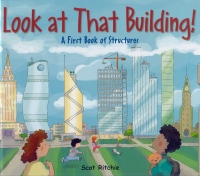| ________________
CM . . . . Volume XVIII Number 12 . . . . November 18, 2011
excerpt:
So begins the narrative of the newest nonfiction book from Scot Ritchie, a well-known illustrator of works for children and the son of architect Ross Ritchie to whom Look at That Building! is dedicated. What you don’t see from this excerpt, however, is the colourful drawing of Martin, Yulee, Nick, Sally, and Pedro, the children introduced in Follow That Map!: A First Book of Mapping Skills (reviewed in CM, Vol. 15, No. 15). These five friends are observing, playing, and jumping over the buildings of a model city with Max the dog and Ollie the cat. The illustration covers the right hand facing page and half of the facing page on the left. The text, divided into heading, narrative, and fact, occupies the half page that remains. This layout continues for the next 24 pages after which a step-by-step illustrated plan for making the prototype of a doghouse out of marshmallows, craft sticks, construction paper, tape and glue is provided. Following Ritchie’s invitation to learn about buildings, readers see the five children and Ollie in a tree house Sally’s father has built for her. Pedro, Nick and Sally are looking out a window frame at Max, far below, who can’t climb up to join them. They think that Max needs a house of his own and decide to walk to the library for a book on building doghouses. Martin suggests they “look at buildings on the way.” Ritchie has the five children observing the excavation for the foundation of what may become a skyscraper, the solid floor of the library and the beams that support each floor, the homes of other animals, the arch, dome, and triangular shapes used in building the city hall, and walls, frames, columns, and windows in a variety of buildings before heading back to the tree house with a roof that protects them from the rain. Ritchie illustrates and describes for his young audience the function of each of these components of a building’s structure. One wonders, however, why this was not done in the context of Sally’s tree house, which not only has many of the features described but is also the setting of several of the most complex and interesting illustrations. At the very least, the obvious connections should have been made or set aside in a section with notes for parents and teachers. As one example, the tree house does not have the type of foundation presented on pages 8 and 9. Its foundation is the tree’s trunk (a sturdy column), and the tree’s branches act as beams. It would be interesting to discuss whether this particular structure is more similar to “nature’s buildings” (e.g., bird nests and spider webs) than the library, school, skyscrapers, city hall, and fire station illustrated. That being said, Look at That Building! is a good introduction to thinking about buildings as particular kinds of structures, and it’s interesting to contemplate what Ritchie’s next book about Martin, Nick, Pedro, Sally, and Yulee will be. Recommended. Barbara McMillan is a teacher educator and a professor of science education in the Faculty of Education, the University of Manitoba.
To comment
on this title or this review, send mail to cm@umanitoba.ca.
Copyright © the Manitoba Library Association. Reproduction for personal
use is permitted only if this copyright notice is maintained. Any
other reproduction is prohibited without permission.
NEXT REVIEW |
TABLE OF CONTENTS FOR THIS ISSUE
- November 18, 2011.
AUTHORS |
TITLES |
MEDIA REVIEWS |
PROFILES |
BACK ISSUES |
SEARCH |
CMARCHIVE |
HOME |
